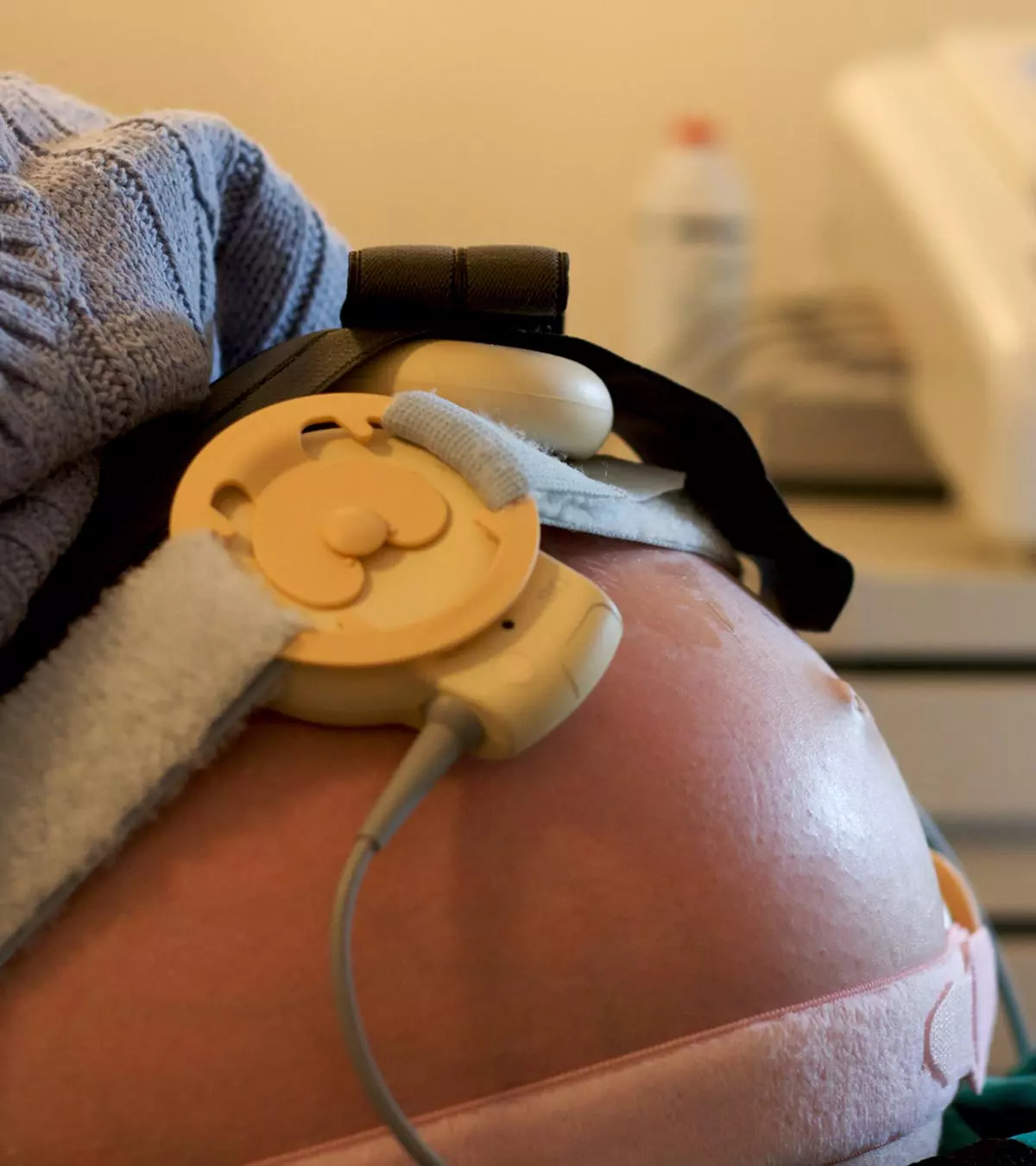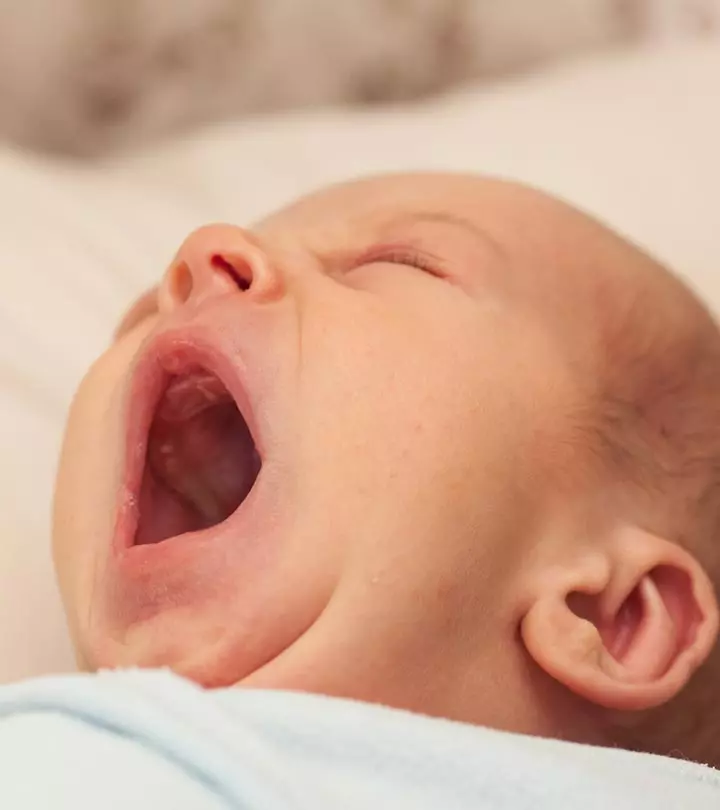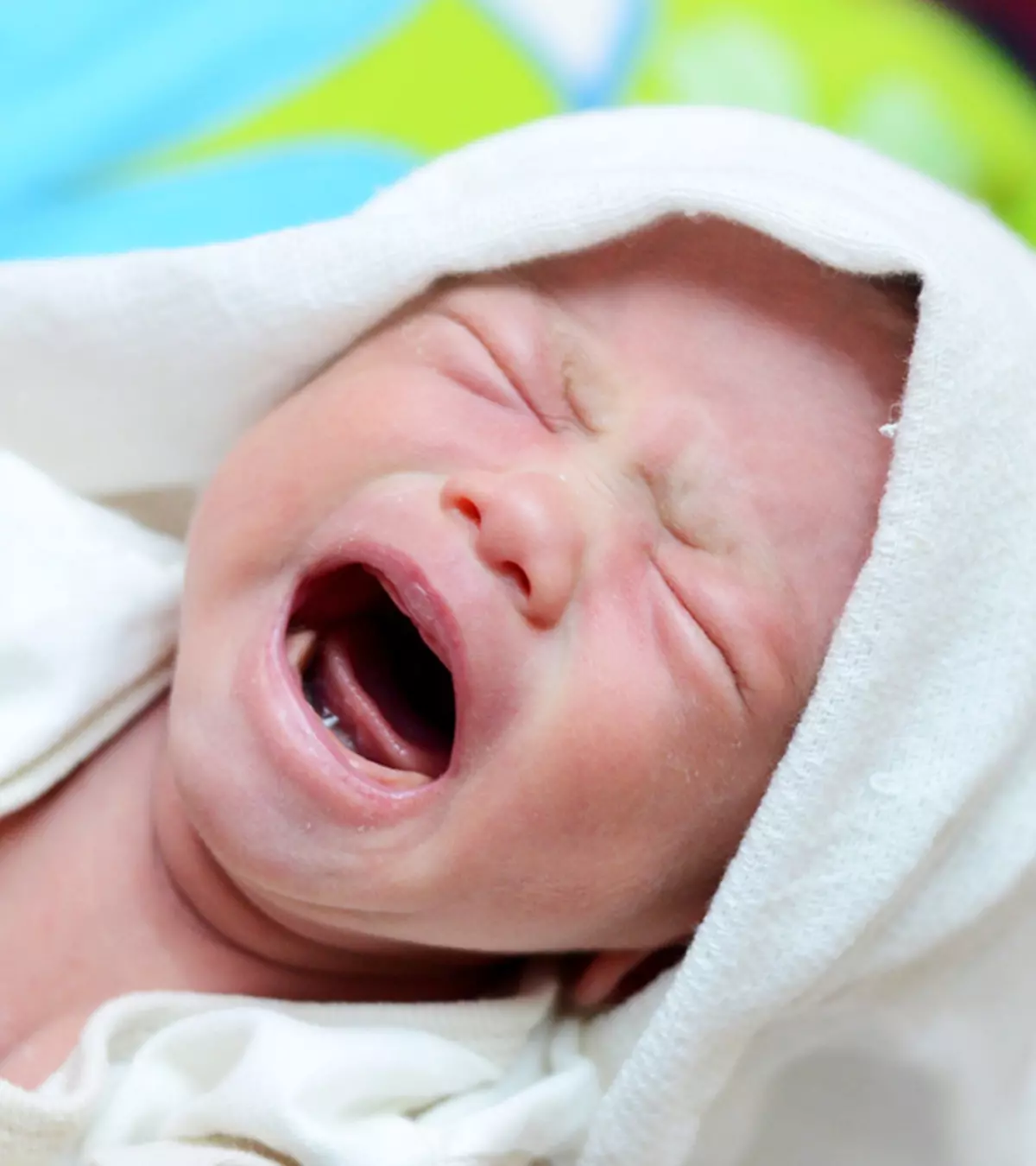
Image: Momjunction Design Team
You may notice a baby shaking their head while interacting with others or playing. Shaking their head from side to side is a common way older infants react to questions or communicate. Though head shaking is common in little ones, it could also indicate neurological or developmental problems.
Read this post to learn more about the typical and uncommon reasons babies shake their heads, how to deal with it, and when to consult a doctor.
Key Pointers
- If a baby is healthy and happy, parents shouldn’t worry about head-shaking in babies.
- Babies shake heads to hone their ability to keep holding their head up, self-soothing, or position their head to latch on to the nipple while breastfeeding.
- Shaking head side-to-side is the most common way older infants respond to a question or communicate.
- However, excessive or repetitive head-shaking indicates an underlying problem that a pediatrician must evaluate.
Normal Causes Of Baby Head-Shaking
Are you wondering why babies shake their head from side to side? If you notice your baby is happy and healthy, then head-shaking is nothing to worry about. Here are a few usual reasons why your baby may shake their head.
1. Developing motor skills
Once your baby’s neck muscles are developed, they test their ability to hold up and move the head. It is a part of normal developmental milestones. Usually, by the end of the first month, a baby starts moving their head from side to side. The Centers for Disease Control and Prevention mention that by the age of two months, they can raise their heads while on their tummy (1). It may be jerkier initially due to developing muscle control and coordination.
2. Self-soothing
A baby shakes its head from side to side as a part of self-soothing. It can be a natural tactic to calm themselves down to sleep. You may notice this behavior right before your little one falls asleep.
Leah Alexander, MD, FAAP, a board-certified pediatrician in New Jersey, says, “If your baby starts shaking their head from side to side, it may be a sign that they are anxious, overstimulated, or trying to fall asleep. Self-soothing is a completely harmless way for babies to try and make themselves feel better in new situations.”
3. While breastfeeding
While breastfeeding, babies may shake their heads to latch. It can be one of the first head movements babies may make. During nursing, they might also shake their head as a gesture to express excitement. Though your baby may support and move their head side to side, you should support their head while feeding until the age of three months.
4. Playing and interaction
Babies start to move their heads as a part of social interaction in the initial months. You may notice increased head shaking when your baby is excited.
5. Communication
A baby may use head-shake as a mode of non-verbal communication.
As the baby grows older, they may shake their head as a reflex, along with making sounds to express emotions or demand something.
 Quick fact
Quick factDr. Alexander says, “Most babies start shaking their heads to express a ‘no’ between 13 and 15 months old. However, some may start earlier and some may not start until later.”
Baby Head-Shaking Causes That Are Not Normal
If head-shake is associated with other physical and behavioral symptoms, then it could be due to developmental problems or certain medical conditions. We will touch on a few:
6. Ear infection or fluid collection in the middle ear
According to the National Institute on Deafness and Other Communication Disorders, five in every six children will experience at least one ear infection by the time they reach their third birthday. Ear infections lead to pain or discomfort. This will often be associated with fever, crying, and other signs of illness. Ear tugging along with head-shaking may then occur (3).
7. Autism spectrum disorder

Image: Shutterstock
Babies with autismiA developmental disability leading to issues with social communication and interaction or repetitive behavior tend to shake their head involuntarily. Frequent headbanging is sometimes observed with this disorder. In such cases, check for these associated behavioral traits.
- Does not respond to sounds
- No reaction if you call their name
- No smile or eye contact
The Centers for Disease Control and Prevention emphasizes that early diagnosis of autism disorders may improve the child’s quality of life due to early interventions and less parental stress (4).
8. Myoclonic epilepsy
Myoclonic head jerks or spasms can be seen in babies during epilepsyiA neurological condition that makes one more susceptible to recurrent seizures . According to the healthcare experts at the Boston Children’s Hospital, these seizuresiA medical condition that causes an involuntary and uncontrollable surge of electrical activity in the brain tend to occur in clusters and may continue to happen multiple times in a day for several days. This may be due to serious neurodevelopmental disorders (5).
9. Spasmus nutans
It is a disorder where babies do head-bobbingiAn act of moving the head up in short and quick movement with rapid eye movement called nystagmus. Sometimes, they may hold their neck in an abnormal position. As per the information available in the US National Library of Medicine, this condition usually occurs between four months and one year of age and resolves later in life (6).
 Did you know?
Did you know?10. Shuddering attacks
Shuddering attacks in infants are involuntary head and upper extremity motions that occur during routine activities but do not impact consciousness. These brief episodes resemble shivering, can be frequent, and may cause alarm among parents due to their seizure-like presentation. They are also sometimes misdiagnosed as epilepsy. Shuddering attacks are characterized by stiffening, tonic posture, and fast shivering motions of the head, upper extremities, and occasionally the trunk. These events typically last from a few seconds to 15 seconds. They usually resolve or improve by age two or three (8) (9).
Repetitive Side-To-Side Head-Shaking When Sleeping

Image: Shutterstock
Shaking of the head side-to-side during sleep can be a symptom of rhythmic movement disorder (RMD). It is a neurological disorder with repeated movement of large muscles before or during sleep and can affect the whole body. It is especially common in infants as part of their early development and is mostly harmless. It usually involves head, limb, and neck movements, which can also occur before sleep when the baby is in a drowsy state (10). Following are the associated symptoms most common in babies and children (11):
- Headbanging
- Body-rocking
- Head-rolling
Sometimes, the baby may also exhibit some less common symptoms, such as (10):
- Leg banging
- Leg rolling
- Body rolling
Sometimes, a child or a baby with RMD may also exhibit rhythmic noises like loud hum sounds (10). This condition might be genetic since it is often seen in families and among twins. Seek a doctor’s opinion if you suspect RMD.
 Quick fact
Quick factHow To Stop Babies From Shaking Head?
Head shaking may cause dizziness and disorientation in babies, and it may result in falls. It might also increase the risk of hitting the crib, table, or wall. You may follow the following tactics to prevent your baby from head-shaking.
- If your baby does it before sleep, then try to find an alternative method to soothe them before they go to bed.
- If it is due to stress or agitation, then create a calm environment in their room.
- Giving a massage would help a baby to relax.

Image: Shutterstock
If you sense that the baby shakes their head as a way to throw tantrums, then do not give in to their demands. As soon as attention is given (even negative attention) it enhances the behavior.
When To Consult A Doctor?
causing hair loss and injury is one of the issues that requires medical examination. You may also consult a pediatrician if you notice any of the following events, along with head shaking.
- Poor interaction with caregivers
- Abnormal eye movements
- Headbanging causing hair loss and injury
- Increased head-shaking during anxiety
- Trying to self-hurt
- Delay in development
- No response to sounds
- Head-shaking after two years of age
 Point to consider
Point to considerHow Is A Baby’s Head-Shaking And Body-Rocking Treated?
In most cases, no treatment is required for the baby’s shaking of the head. However, if it is occurring due to an underlying cause, such as ear infection and ASD, the pediatrician and specialist may treat the disorder to control the shaking of the head and the rocking of the body.
Even if your baby is diagnosed with RMD, it does not require treatment in most cases. However, if your baby is at risk of injury, the healthcare provider may suggest some ways to help, such as (13):
- A protective helmet when your baby is sleeping to reduce the risk of head injury.
- Advise to make your baby’s bedding on the floor, away from the walls.
Frequently Asked Questions
1. Can teething cause a baby to shake their head?
Some babies may shake their heads during teething. They may shake heads as a self-soothing behavior to cope with teething pain (14). It is a normal behavior in developmentally healthy infants during teething.
2. Why does my baby jerk their head back and forth?
Occasional back-and-forth movements of the head can be normal, especially when your baby is falling asleep. However, persistent bobbing of the head that is back and forth can be a sign of neurological problems such as bobble-head doll syndrome (BHDS). This can be due to cystsiA sac-like structure that may contain fluid, air, or other material in the ventricles of the brain and can be treated with surgeries (15).
3. Do babies shake their heads when they are tired?
When tired, some babies shake their heads side to side to soothe themselves and fall asleep. Generally, this movement isn’t a cause for concern and is a mechanism some babies employ to feel less anxious.
4. How long do rhythmic movement disorders (RMDs) last?
In the case of RMDs in babies or children, each individual movement, such as head rocking or rolling, may only last one or two seconds. However, one episode of RMD may last up to 15 minutes (10).
5. How can I differentiate between normal and concerning head-shaking behaviors in my baby?
While head-shaking behavior in babies is mostly benign, contact a pediatrician if you observe other symptoms in your baby, such as fever or rashes suggesting infection, signs of injuries, seizures, or worsening of movement behaviors when stressed or irritated (13).
Baby shaking its head when awake and happy is typical and a good sign of motor skill development. They may use this action to interact and communicate. However, if you notice them shaking during their sleep or together with other concerning symptoms, do not overlook it. Although typical, a baby shaking head with crying, rapid movement, and other signs can indicate underlying morbidity that may require medical intervention. So stay mindful of your baby’s movements and behavior, and do not hesitate to consult your child’s doctor for prompt diagnosis and treatment.
Infographic: Less Serious Reasons For Baby Shaking Head
Although sometimes it might indicate a medical issue, generally, babies shake their heads in response to diverse stimuli. However, be observant of any unusual signs accompanying head shaking in babies. This infographic tells you about the possible common reasons infants usually resort to shaking their heads. Illustration: Momjunction Design Team
Illustration: Causes Of Baby Shaking Head Side-To-Side & How To Stop It

Image: Dall·E/MomJunction Design Team
Learn about the 8 common early signs of autism. Discover what signs to look for in your child’s development and how to get help.
References
- Important Milestones: Your Baby By Two Months; Centers for Disease Control and Prevention
- Hearing & Making Sounds: Your Baby’s Milestones; American Academy Of Pediatrics
- Middle ear infection: Overview; Institute for Quality and Efficiency in Health Care; Cologne, Germany
- Screening for Autism Spectrum Disorder; Centers for Disease Control and Prevention
- Movement Disorders In Depth; Boston Children’s Hospital
- Spasmusnutans; The United States National Library of Medicine
- Sandifer Syndrome; Birth Injury Help Center
- Wang JJ and Goldman RD; 2021; Shuddering attacks; National Library Of Medicine
- Millichap, J.G.,Shuddering Attacks; 2001; Pediatric Neurology Briefs
- Rhythmic Movement Disorder; Sleep Foundation
- Jun Kohyama and Tomoyuki Takano, A boy infant with sleep related rhythmic movement disorder showing arm banging; Brazilian Association of Sleep
- Sleep Rhythmic Movement; American Academy Of Sleep Medicine.
- Head Banging and Body Rocking; Cleveland Clinic
- Hannah M Tully,et al; Persistent figure-8 and side-to-side head shaking is a marker for rhombencephalosynapsis; National Library Of Medicine
- Bobble-head doll syndrome; National Organization for Rare Disorders
Community Experiences
Join the conversation and become a part of our nurturing community! Share your stories, experiences, and insights to connect with fellow parents.
Read full bio of Dr. Elna Gibson
- Dr. Leah Alexander is a board-certified pediatrician who provides medical care in an outpatient setting in Fair Lawn, New Jersey. She has also been working as a pediatrician with Medical Doctors Associates at Pediatricare Associates, New Jersey, since 2005. Dr. Alexander holds a bachelor's degree in Health Science from Kalamazoo College and a Doctor of Medicine degree from Michigan State University.
 Dr. Leah Alexander is a board-certified pediatrician who provides medical care in an outpatient setting in Fair Lawn, New Jersey. She has also been working as a pediatrician with Medical Doctors Associates at Pediatricare Associates, New Jersey, since 2005. Dr. Alexander holds a bachelor's degree in Health Science from Kalamazoo College and a Doctor of Medicine degree from Michigan State University.
Dr. Leah Alexander is a board-certified pediatrician who provides medical care in an outpatient setting in Fair Lawn, New Jersey. She has also been working as a pediatrician with Medical Doctors Associates at Pediatricare Associates, New Jersey, since 2005. Dr. Alexander holds a bachelor's degree in Health Science from Kalamazoo College and a Doctor of Medicine degree from Michigan State University.
Read full bio of Dr Bisny T. Joseph
Read full bio of Rohit Garoo
Read full bio of Shinta Liz Sunny



















